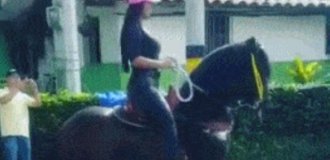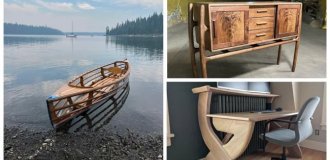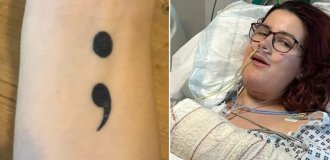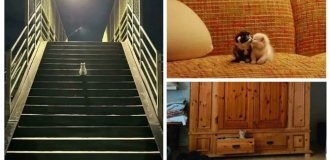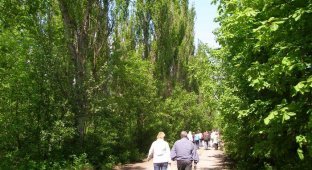Explosion at the Chernobyl Nuclear Power Plant (10 photos)
Let's remember this catastrophe again. It all happened so long ago, in 1986. Read more about the Chernobyl nuclear power plant in this post.

This word has become synonymous with terrible disasters that caused great casualties. The accident at the Chernobyl nuclear power plant dealt a heavy blow to Ukraine. Chernobyl is a small city located on the banks of the Kyiv reservoir, between the Uzh and Pripyat rivers, a city surrounded by green forests. In the summer, many people came here to relax because the places were very colorful. Not long ago, a city was built on the Pripyat River and they called it Pripyat. It was a garden city! Beautiful boulevards and lots of greenery make it a pleasant holiday destination.
In 1972, the most powerful nuclear power plant in the USSR began to be built right next to Chernobyl. By 1985, they had already finished building four power units and began building a fifth. The night of April 26, 1986 did not foretell anything bad. An experiment on permissible load was conducted at a nuclear power plant. But what an experiment! The entire protection system of the power unit was turned off, and it went into an uncontrollable state. The operators tried to stabilize the situation, but it was too late. And so, at exactly 1 hour 24 minutes at night, two explosions were heard at reactor 4, and it began to burn.

Within five minutes the firefighters were on the spot. By morning they managed to localize the fire and put it out. But the worst was yet to come. The fourth reactor was completely destroyed; pieces of uranium and graphite emitting radiation were scattered throughout the territory of the nuclear power plant. And the cities continued to live their lives for two more days. No one warned residents about the disaster. Hundreds of thousands of people walked in the streets and went out into nature. Cycling competitions took place in Kyiv. The days turned out to be hot, many people decided to spend them outside the city. And no one felt that the green grass and trees had become their enemies. Some people received such doses of radiation that they died after a while.
On April 28, a convoy of 1,100 buses transported residents from Pripyat, Chernobyl and other populated areas of the exclusion zone. They were only allowed to take their ID cards and some food with them. All the rest of the property was abandoned. And therefore, the first days after the accident, apartments with all their property, stores filled with goods were a real paradise for looters. With great difficulty, the police managed to prevent the theft of property. Life within a radius of 30 km from Chernobyl came to a standstill, with only occasional thrill-seekers appearing there.

Meanwhile, work at the Chernobyl nuclear power plant was in full swing. After the reactor burned down, it was necessary to dump all the fragments of uranium and graphite from the roofs and collect them throughout the territory. But first, a few words about the structure of the reactor.
The reactor is a huge pit filled with graphite. The walls, bottom and roof of the reactor are made of lead (Lead is practically the only substance that does not allow radiation to pass through). Holes are made in the graphite into which uranium fuel rods are inserted. Nuclear reactions produce enormous amounts of heat. (A palm-sized piece of uranium contains more energy than an entire trainload of coal. In addition, nuclear power plants, unlike thermal power plants, do not burn atmospheric oxygen and do not pollute the atmosphere). The heat is supplied to steam turbines, which generate current. The turbines are located in a building above the reactor. The top of the reactor is closed with a lid. The force of the explosion blew out the lid, and everything inside began to burn.

In the first days it was impossible to approach the reactor, since the temperature in it reached 5 thousand degrees. At this time, a radioactive cloud was hanging over the nuclear power plant, which was carried by the wind. The cloud circled the globe three times, resulting in a lot of radiation spreading throughout Europe. Of course, Ukraine and Belarus suffered the most.
Meanwhile, the liquidators tried to somehow drive the cloud to the ground. From a helicopter, the reactor was bombed with sand and watered. But everything was very ineffective, and 77 kg of radiation ended up in the air. And this is equivalent to dropping a hundred (!) atomic bombs on a nuclear power plant, all at the same time.

When the reactor burned out, it was necessary to collect all the fragments of uranium and graphite. All work was carried out manually. Liquidators in gas masks and lead suits shoveled and picked out pieces of radioactive material with their hands, dumping them into the burnt reactor. After clearing the area, work began on constructing a sarcophagus (a huge box) over the reactor in order to prevent radiation leakage. The “Shelter” project is currently being developed and implemented, according to which the fourth reactor will be completely lowered underground, and it will forever cease to be a headache.
After the Chernobyl accident, many advocated its closure. In December 2000, it was closed due to an outdated and imperfect security system.
snosti.

But what about the radiation that took hundreds of hectares of land from Ukraine? The decay period of different radioactive particles varies - from eight minutes to hundreds of thousands of years, but almost all of them (except uranium) decay within 30 years. So it is likely that in 15-20 years people will return to Chernobyl and Pripyat and live again, and they will become beautiful again
cities...
Current state of the Chernobyl nuclear power plant
A brief overview of the current state of the State Specialized Enterprise of the Chernobyl Nuclear Power Plant (SSE Chernobyl Nuclear Power Plant), as well as an overview of the work carried out by the personnel of the nuclear power plant today. The prepared material has a general appearance without going into details of the activities carried out at the Chernobyl NPP. To obtain more detailed information and technical details of the described activities, we recommend visiting the official website of the Chernobyl Nuclear Power Plant.

Characteristics of the territory where the Chernobyl nuclear power plant is located
The territory where the industrial infrastructure of the Chernobyl nuclear power plant is located today is called the “Industrial (or production) site of the Chernobyl nuclear power plant.” According to the classification of lands in the Chernobyl exclusion zone and the zone of unconditional (mandatory) resettlement, these territories belong to the “industrial part” of the zone.

The total area of the industrial part of the exclusion zone is about 54,000 hectares. The main feature of these lands is the presence of significant levels of radioactive contamination of the soil at the industrial site. The average level of surface contamination with plutonium isotopes is about 300,000 Bq/m2, while on 20,000 hectares of the Chernobyl NPP territory the levels of plutonium contamination exceed 4,000,000 Bq/m2. In these areas, complete decontamination is impossible.
The territory of the construction site of the third stage of the Chernobyl NPP, construction base, etc., the total area of which is about 3,600 hectares, is assigned to the SSE ChNPP (according to the land allotment act). Technological elements of the Chernobyl Nuclear Power Plant are also a cooling pond and hydraulic structures, which are adjacent to the Chernobyl Nuclear Power Plant from the southeast. It is worth noting other bodies of water that are located near the Chernobyl nuclear power plant - the Pripyat River, Lake Azbuchin. In the area where the station is located, the Pripyat River is about one hundred meters wide and flows along an artificial channel.
The area surrounding the Chernobyl NPP industrial site also has high levels of radionuclide contamination (for 137Cs up to 4x107 Bq/m2, for 90Sr up to 3.5x107 Bq/m2; for plutonium isotopes up to 8x104 Bq/m2).
Current state of the Chernobyl nuclear power plant
SSE ChNPP, after the shutdown of the 3rd power unit in 2000, is in the mode of termination and decommissioning. The cessation of electricity generation at the Chernobyl nuclear power plant was carried out on the basis of the “Memorandum of Understanding between the G7 governments, the Commission of the European Community and the Government of Ukraine on the closure of the Chernobyl nuclear power plant” signed by the Government of Ukraine.
All Chernobyl reactors are undergoing decommissioning work.
The total number of personnel at SSE ChNPP today is about 3.5 thousand people. A significant number of contractor personnel (about 2 thousand people) are also involved in work at the Chernobyl nuclear power plant.
In preparation for the decommissioning of the Chernobyl nuclear power plant, new facilities are being built at the industrial site. So in 2001, an industrial heating boiler house was built at the Chernobyl nuclear power plant site.
One of the most important tasks carried out by the Chernobyl NPP is the creation at the industrial site of production facilities for the management of liquid and solid radioactive waste (RAW) that were generated during the operation of the Chernobyl NPP, as well as those RW that were generated during the decommissioning of the Chernobyl NPP .

It is worth noting that the work on decommissioning the Chernobyl NPP is carried out on the basis of the “Concept for decommissioning of the Chernobyl NPP power units,” which stipulates that before the start of the final closure of the Chernobyl NPP, the following facilities must be created:
Liquid Radioactive Waste Processing Plant (LRWTP);
Spent nuclear fuel storage facility (ISF-2),
Industrial complex for solid radioactive waste management (SRSW);
A storage facility must be organized for the temporary storage of high-level radioactive waste (HLW) and much more.
The implementation of these projects is carried out at the expense of international assistance to Ukraine for the decommissioning of the Chernobyl Nuclear Power Plant, as well as the State Budget of Ukraine.
Decommissioning will be carried out according to the delayed dismantling option, which implies long-term storage of such power unit elements as reactors, CMPC, etc. in a mothballed state. The total aging period for these elements can range from 50 to 100 years.
According to the approaches that are set out in the specified “Concept...”, the ultimate goal of decommissioning the Chernobyl nuclear power plant is a state called
"brown spot" Ultimately, it is expected that all equipment at the Chernobyl NPP will be dismantled and all contaminated structures and structures will be decontaminated (to an acceptable level).
Liquid radioactive waste processing plant
The plant is designed for processing and further conditioning of liquid radioactive waste by cementing.
The construction of the ZhRWDF is carried out according to a project approved by the Cabinet of Ministers of Ukraine.
Industrial complex for solid radioactive waste management (SROW)

The industrial complex consists of a number of separate facilities that will interact in the chain of management of solid radioactive waste of the Chernobyl nuclear power plant - extraction, processing and disposal.
The extraction of solid radioactive waste from the existing Chernobyl NPP storage facility will be carried out by a special installation, which will fragment and load the recovered radioactive waste into containers. Containerized radioactive waste will be supplied to a special plant for processing solid radioactive waste.
The main task of the plant is to process and sort all types and categories of solid radioactive waste. The plant will process and condition all types of low- and medium-level radioactive waste. This will be done by burning, pressing and cementing the waste. Ultimately, at the plant, radioactive waste will be placed in concrete containers followed by concreting.
Containers with concreted radioactive waste will be buried in a special near-surface storage facility for solid radioactive waste, which has already been built on the territory of the exclusion zone.



